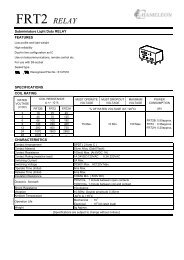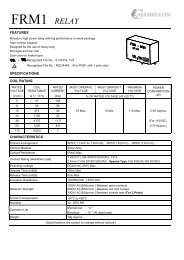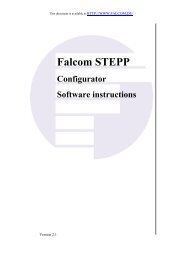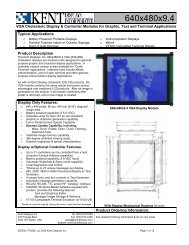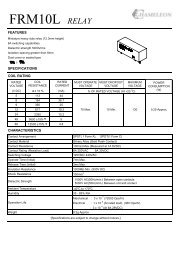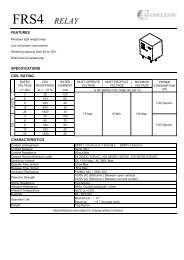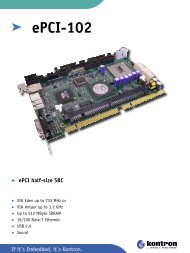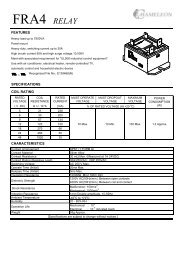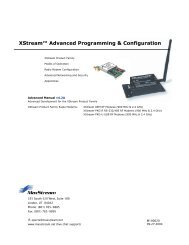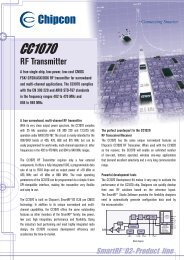STANDARD SERIAL COMMUNICATION INTERFACE and ...
STANDARD SERIAL COMMUNICATION INTERFACE and ...
STANDARD SERIAL COMMUNICATION INTERFACE and ...
You also want an ePaper? Increase the reach of your titles
YUMPU automatically turns print PDFs into web optimized ePapers that Google loves.
St<strong>and</strong>ard Serial Interface Protocol Description<br />
module will assume the message cycling is to resume indefinitely, overriding the "sleepmode"<br />
feature of the display module (Not recommended for long term battery operation).<br />
6. = Off (non-inverted), <strong>and</strong> On (inverted)<br />
7. = Off, for On.<br />
8. ON Update Method – Byte to indicate how the controller is to present the respective partial image<br />
or message. The following codes apply:<br />
= “Wipe-ON” image presentation method (not valid for graphic messages). Characters<br />
within the image will appear to “grow” to the right as the text message is presented.<br />
Unlike the “Scroll-ON” method, characters to the left already presented in a previous<br />
frame will be stationary while new characters within the image are presented to the right.<br />
= “Scroll-ON” image presentation method (not valid for graphic messages). Characters<br />
within the image will appear to move to the left as the text message is presented. Unlike<br />
the “Wipe” update method, all the characters within the image will move until the final<br />
frame of the image is presented.<br />
= “Close-ON” image presentation method. This presentation method provides the<br />
illusion that the partial screen image is “sliding” down from the top <strong>and</strong> “sliding up from<br />
the bottom, until the final frame provides the completed image joined together.<br />
= “Open-ON” image presentation method. This presentation method provides the<br />
illusion that the partial screen image is “sliding” up <strong>and</strong> down from the center, until the<br />
final frame provides the completed image which has been completely “opened” from the<br />
center.<br />
= “Rotate-ON” image presentation method. This presentation method provides the<br />
illusion that the partial screen image is vertically rotating from the “Up-right” position, till it<br />
reaches an “Upside Down position”, then the frame sequence is reversed till the final<br />
frame of the “Up-right” position is reached.<br />
= "Swell-ON' image presentation method. This presentation method is used as an<br />
alternate method of generating a static frame of data. Unlike the previous methods<br />
where multiple frames are presented to the user, this method will only generate a single<br />
frame representative of the text or graphic data provided at the interface. This method<br />
will automatically use the “No OFF” OFF update method, outlined in the next bullet text<br />
section. Unlike the "Fade-ON", this update method will erase the screen section prior<br />
(hence destroying the previous image) to generating the image in the cumulative drive<br />
method, hence creating an illusion that the new image will grow in brightness or "Swell"<br />
from a blank background during the update.<br />
= "Fade-ON" image presentation method. Like the "Swell-ON", this method is used as<br />
an alternate method of generating a static frame of data. This method will automatically<br />
use the “No OFF” OFF update method, outlined in the next bullet text. Unlike the "Swell-<br />
ON", this update method will NOT erase the screen section prior to generating the image<br />
in the cumulative drive method, hence creating an illustion that the new image section will<br />
start to appear as the previous image starts to disappear, hence the new image will<br />
appear to "Fade" over the previous.<br />
11. OFF Update Method – Byte to indicate how the controller is to remove the respective partial<br />
image or message. The following codes apply:<br />
= “Wipe-OFF” image removal method (not valid for graphic messages). This removal<br />
method is the opposite of the “Wipe-ON” presentation method, with the characters being<br />
removed from right to left. The left-most character is the last character removed from the<br />
image area.<br />
= “Scroll-OFF” image removal method (not valid for graphic messages). This removal<br />
method is the same ast the “Scroll-ON” presentation method, with the characters being<br />
removed from right to left. The right-most character is the last character removed from<br />
the image area.<br />
= “Open-OFF” image removal method. This removal method is the opposite of the<br />
“Close-ON” presentation method, with the characters being removed from center towards<br />
St<strong>and</strong>ard Serial Communication Interface Description, © 1998-2002 Kent Displays Inc., doc. # 25016 Revision T, Page 48 of 52



